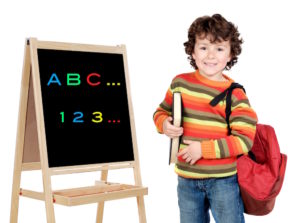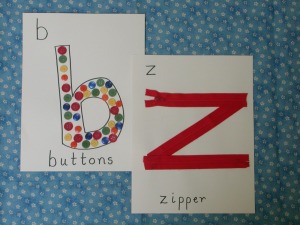
Don’t teach your children their abc’s,” I tell surprised parents of three-year-olds. “They’ll learn their abc’s later, but to be wonderful readers they need to learn something else first.”
Most of us learned the letter names, as we sang our “abc’s” (aye-bee-sees). To learn to read faster and more efficiently, help your children learn the a-buh-cuh’s or the sounds the letters represent.
The skills of letter recognition and phonemic awareness (hearing the individual sounds in words) work hand in hand and develop together. The sounds may be introduced first, through games like I Spy and songs. (See the article Reading Begins at Birth for more information.)
To begin the work of letter recognition with a three-year-old, I introduce letter symbols after the child has learned the sounds of the letter of the alphabet.
For the five year old, I introduce a letter a day, so that we can get through the entire alphabet in about a month.
When your child has letter and sound recognition of about fifteen letters, you can then begin word-building games, and then the road to reading really begins to pick up speed.
Introduce lower case letters first to your child. The reason for this is simply that it makes your child’s learning easier. If you introduce both lower and upper case alphabets at the same time, there will be fifty-two symbols to recognize instead of twenty-six. Also, over 95 percent of all printed matter is in lower case writing. Introduce the capital letters to your child after they have mastered the lower case alphabet with a simple matching game. More often than not, children will “discover” the capital letters on their own, and the sounds they represent. Self-discovery makes learning more fun and rewarding.
To introduce the letters and their sounds to your child, make a set of cards with your child.
Depending on the age of your child, you may want to make one a week or one a day or perhaps the whole set in a morning. I’ve done it all! This set of cards will be fun to make and use because it will be your child’s own work of art. You don’t have to start in ABC order either. Start with the letters in a child’s name or the first initials of family members, whatever seems to be of interest to your child. Below is a description of this activity.
ARTISTIC ALPHABET
Purpose: To introduce the child to all the letter sounds and letter shapes of the alphabet
Materials:
- Twenty-six 5×7 index cards or other heavy weight paper
- Various materials to glue onto each letter card, names of which begin with a corresponding letter, such as m – macaroni, b –beans, etc. These can also be stickers, magazine pictures, etc.
- Scissors
- Glue
- Basket to store cards
- On each card draw a dark outline of a lowercase letter. Then glue on the corresponding materials.
Set aside to dry. When dry, display in the basket.
For the next day, or week, do letter and sound recognition activities for that letter.
Take the letter “m”, for example:
- Eat things that start with the letter m, milk, macaroni, marshmallows, mashed potatoes, meatloaf, etc.
- Go on a “m” hunt in your house, yard or neighborhood.
- Make a “‘m” poster or cards with cutouts from a magazine.
- Dance like a monkey while holding the letter “m”.
- Moo like a cow. Meow like a cat. Etc.
- Make a necklace with the letter.
- Have your child use his index and middle fingers to trace over the 3-D alphabet card.
- Use salt dough to make the letters.
- Write the letters with chalk on the sidewalk, or patio, or driveway.
Let your child help find materials to correspond to their letters. Here are some ideas:
- apple seeds, ant, apple or alligator stickers
- beans, buttons, beads
- cotton balls, corn seed, colored comics, cloth
- dots from a hole punch, dirt (only for the adventurous!)
- eggshells
- feathers, flag stickers
- glitter, gauze, gift wrap
- hay
- igloo, iguana stickers or drawings
- jelly beans, old jewelry
- keys, pictures of kiwis
- lace, lollipop wrappers
- macaroni
- nutshells
- pictures of otter or octopus
- peanuts, popsicle sticks
- q-tips(flexible kind)
- rubber bands, rice
- sand, salt, string
- tape
- umbrella stickers or pictures
- velvet, Velcro
- wallpaper, watermelon seeds
- I usually make little exit signs or boxes to glue on the card
- yarn
- zippers (from old clothes)
Keep these letter cards handy and review them everyday as your collection grows. Sound by sound, your child will learn to hear the sounds of our alphabet.



This is such good advice. Thank you!
My question is, do you introduce the letters in alphabetical order? Or is there a more helpful order to introduce them?
Jessica,
It doesn’t matter the order you work on the letters.
Usually I start on the ones in a child’s name first. Or m and o for mom, or d and a for dad!
What we are working for is to that the child will recognize a letter no matter what order it is in. Always seeing letters in alphabetical order can create a dependence on that order.
I’ve seen children sing their way through the alphabet to try to figure out the name of a letter.
We want to go slow and not rush the process of learning the letter shapes and their sounds.
I encourage you to sign up for my webinar, Steps To Reading Success.
Sign up here:
http://marenschmidt.com/steps-to-reading-success/
Thank you! Will do!